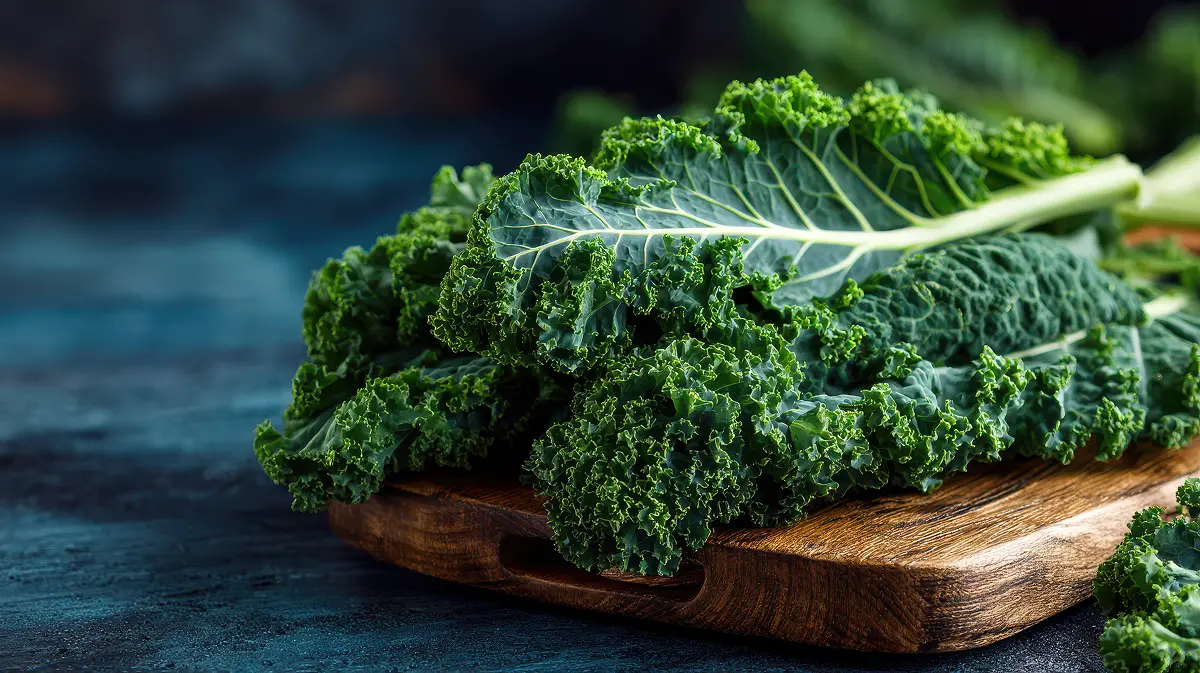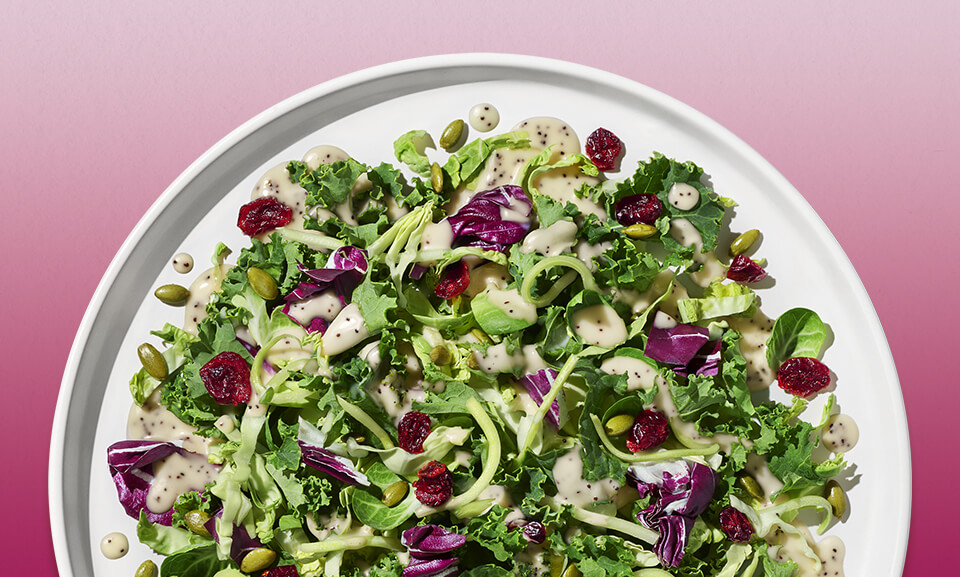Kale Nutrition
Robustly green and sometimes a little misunderstood, kale has definitely earned its reputation as a nutrient heavyweight — but it’s also a multi-talented veggie ready to enhance everything from salads to breakfast. Those deep‑green, ruffled leaves deliver a satisfying crunch along with a full lineup of vitamins and minerals.
Low in calories yet rich in vitamin C, vitamin K, and fiber, kale makes it easy to get more nutrients without overthinking your meals. However it lands on your plate (or in your blender), kale deserves a regular spot in your refrigerator.


What is the nutritional value of kale?
Kale may be low in calories—about 35 calories per raw cup—but it’s bursting with good things like vitamins, minerals, and phytonutrients. A single cup (raw) generally provides:
- More than 100% of your Daily Value (DV) of vitamin K
- Over 70% of your DV of vitamin C
- A generous helping of vitamin A (as beta‑carotene)
- Small (but meaningful!) amounts of calcium, potassium, and magnesium
- Just under 3g of protein (quite respectable for a leafy vegetable, actually)
All of these nutrients come wrapped in only 0.5g of fat and about 7g of carbohydrates.

“Kale absolutely deserves a spot on everyone’s plate,” says Andrea Mathis, MA, RDN, LD. “This leafy green contains so many benefits, offering a super-efficient way to boost your intake of vitamins C and K, which support immune health, collagen production, and bone health.”
What is the nutritional difference between kale and spinach?
Spinach definitely earns its nutritional accolades, but kale holds its own and then some. Kale typically contains twice the vitamin C and about seven times the vitamin K found in an equal serving of spinach. Spinach, on the other hand, offers a bit more folate and iron per cup.
In terms of culinary attributes, spinach is tender and mild, making it easy to tuck into virtually any dish. Kale’s leaves are sturdier with a heartier, slightly earthy flavor that stands up well to heat. Both greens are versatile — spinach wilts quickly, perfect for last‑minute additions to soups or pastas. Meanwhile, kale keeps its structure for the most part, lending a satisfying bite to sautés, stews, and grain bowls.
If you can’t decide, do what we do: use both! Pairing kale with spinach balances flavor while giving your dish an even broader nutrient spectrum.
Does kale have fiber?
Hearty greens are known for their fiber, and kale is no exception. Kale contains about 2.5 g of fiber per cup, supporting digestion and helping you stay satisfied. “If hitting your daily fiber goal feels like a struggle, start simple by incorporating one cup of chopped kale into your favorite soup, smoothie, or pasta recipe,” says Andrea Mathis, MA, RDN, LD. “This will help to bump up the fiber content without changing the flavor profile.”
A quick pro tip: If you’re making salad with raw kale, spend a minute massaging the leaves with a drizzle of olive oil and a pinch of salt. This softens the fibers, making the kale easier to chew and digest while delivering that silky‑tender texture.
What vitamins does kale have?
Vitamin C: Kale delivers roughly 70mg per cup — more than the vitamin C content of an entire clementine. Vitamin C plays a vital role in collagen production, immune support, and iron absorption.
Vitamin K: With well over 100% DV per cup, kale supports healthy blood clotting and bone metabolism.
Aside from the heavy hitters, kale also contains beta‑carotene (converted to vitamin A), manganese, and a range of powerful antioxidants like quercetin and kaempferol that help fight oxidative stress.


How much kale should you eat in a day?
There’s no official kale quota, but many dietitians suggest 1–2 cups of leafy greens daily. That could translate to a big kale salad at lunch or a handful of chopped kale tossed into your evening pasta sauce. If you’re new to kale, start with smaller amounts to let your digestive system adjust to the extra fiber.
Is raw or cooked kale more nutritious?
Whether cooked or right out of the bag, both have perks. Raw kale preserves vitamin C and delivers maximum crunch — perfect for salads, smoothies, and slaws. Cooked kale (steamed, sautéed, or roasted) shrinks dramatically, letting you eat more leaves in one sitting. Cooking also reduces oxalates, making kale’s calcium and iron easier for your body to absorb.
Bottom line: Mix it up! Enjoy kale raw for crisp freshness, and cook it when you need a satisfying side or want to pack more greens onto the plate. (This hearty Kale Sauté with Mushrooms and Bacon recipe is a good place to start.)
Simple ways to add kale to meals
Here are a few easy ways to get up and running with kale in the kitchen:
- Kale Chips: Toss some de‑ribbed kale leaves with olive oil, sprinkle with sea salt, and bake at 300 °F until crisp for a satisfying snack you won’t feel guilty about.
- Breakfast Boost: Stir handfuls of baby kale into scrambled eggs or a tofu scramble to infuse your first meal of the day with more flavor and nutrients.
- Power Smoothie: Blend kale with pineapple, banana, and coconut water for a tropical twist! Kale plays well with lots of different combinations, so go wild with the experimenting.
- Hearty Soup: Add chopped kale to minestrone or white‑bean soup during the last 10 minutes of simmering.
- Salads: Yep, you knew this was coming. The easy route is to simply grab a bag of our ever-popular Sweet Kale Chopped Salad Kit that’s ready in a matter of minutes. Want to construct your own masterpiece? Our pre-washed, pre-prepped Chopped Kale is your secret weapon.
And while you’re here, take in some more kale recipe inspiration:


Don’t bail on kale
Versatility and nutrition in one leafy package? Kale is hard to beat. Its earthy flavor works equally well in salads, lightly sautéed beside as a side, baked into chips, stirred into soups, blitzed into a morning smoothie, or really whatever else you can come up with.
So, next time the produce section calls, grab yourself a bundle — or make life easier with our selection of ready-to-use chopped kale, Kale & Veggies blend, and Chopped Salad Kits. No matter how you prep it, the more you can incorporate kale into your meal routines, the better.
